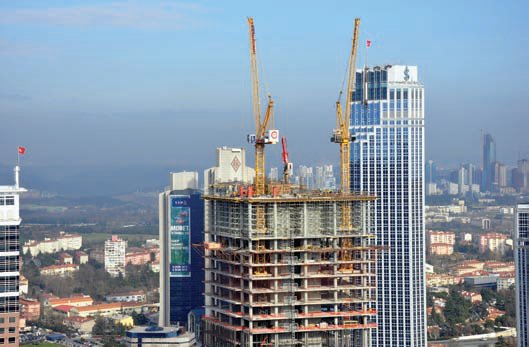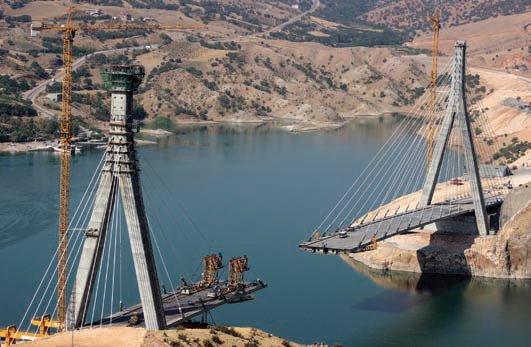Gateway to the east
22 January 2015Current growth in Turkey is being driven not just by domestic projects, but by the country’s proximity to another burgeoning region, Central Asia. Daniel Searle reports.
The Turkish construction market has gone from strength to strength in recent years, despite the country's proximity to many of the European markets that have suffered in the economic slowdown.
In a report from market research company Timetric, the construction industry in 2013 was worth TRY158.3bn ($69.8bn), having grown at a compound annual rate of 12.6% from 2009.
That growth was fuelled primarily by residential developments-which accounted for just over half the value of the construction market- and government investment in infrastructure, which represented around one-third of the market.
Demand for housing is being driven by the country's growing middle class population and urbanisation, while the investment in infrastructure-almost half of which is being spent developing motorways and other road projects- reflects the importance of the country's geographical role as the gateway between Europe and Asia.
Meanwhile, the energy sector is expanding as well-driven by increasing demand for power that will require an estimated TRY226.9bn of investment to meet 2023 levels, according to the Investment Support and Promotion Agency of Turkey. And while the construction market slowed a little in 2014, Turkey remains an important crane rental companies and manufacturers-who also noted the increasing importance of other Central Asian countries.
"In the last five years, Turkey has been a very important market for us, particularly due to the number of construction projects," says Wolfgang Pfister at Liebherr Nenzing, which covers duty cycle crawler cranes, lift cranes up to 300t, foundation equipment and maritime cranes.
"2014 has still been strong and Turkey remains very important, but the market has come down in the construction sector. The change in the currency exchange rate has affected demand-there is now some uncertainty in the market and some projects and investments have been postponed. The maritime sector, however, has not been affected.
Sales have been realised in the port equipment and ship crane sector. "Recent growth has come mainly from infrastructure projects and high-rise buildings. Our equipment is often used on the preparation work for high-rise developments-for these preparatory works we also supply foundation equipment such as large rotary drilling rigs."
Sinan Türeyen, group director for tower cranes at crane company TeknoVinç also cites high-rise buildings as a driver in the booming construction industry: "For the last ten years in Turkey, high-rise buildings have become popular-for offices, shopping malls and residential buildings," he says.
"This was initially in Istanbul and is now the trend in other cities as well. Therefore we have seen an increase in demand for tower cranes, as well as our construction hoists.
"From 2008 we have begun using internal climbing systems with our tower cranes, thanks to the support from Potain. We are the first crane company in Turkey to offer this technology, and it is now used in almost every high-rise development where space is tight, such as in highlypopulated cities like Istanbul.
"As well as high-rise developments, we have also seen demand for cranes for the construction of hydro-electric power plants, and infrastructure such as highways and bridges.
"This includes prestigious projects such as the Yavuz Sultan Selim Bridge, which is being constructed over the Bosphorus, and the cablestayed Nissibi Euphrates Bridge, to which we supplied two tower cranes. "There are a lot of projects taking place in Istanbul, but also in other cities in Turkey such as Îzmir, Adana, Ankara and Kayseri. These projects cover infrastructure, residential developments, and more."
The large number of relatively short-term projects in Turkey has also boosted demand for crane rental, says Türeyen: "The levels of construction in Turkey are acceptable, although the crane rental business is currently much stronger than crane sales. Sales of tower cranes are stable, but our rental business is doing better than last year-around 95% of our rental fleet is currently being used. "Rental is strong for two reasons. Firstly, some customers are currently cautious due to uncertainty over the economy. Secondly, there are lots of projects taking place, many of which are completed relatively quickly, within 18 months. Therefore it is not affordable or necessary to purchase a new crane for each new project."
The growth in energy plant projects has boosted the Turkish business of crane company Hareket, says general manager Engin Kuzucu: "We have been transporting power plant components from southern Turkey to northern Iraq. This includes transporting the transformers from the ports to the facilities.
"We have also been working on the installation of wind farms in Turkey, and on infrastructure projects including bridges such as the Izmit Bay Bridge, and access roads for refineries."
"I am optimistic that growth will continue in 2015-16, in and around Turkey."
Power plants are also one of the key sectors for Sarilar, says Recep Özbey: "Transportation and installation of wind turbines are currently providing us with a lot of business," he says.
"As are hydroelectric and thermal powerplant constructions, and steel construction like stadiums and bridges, such as the Türk Telekom Arena, the Golden Horn Metro Bridge, and the Dilovasi-Yalova bridge. "In the power plant sector we are working at wind farm projects in Hatay, Izmir, Hatay and Bahçe, and thermal power plants at Çatalagzi and Yazicilar. "We are also working on other projects including ports, malls, cement factories and so forth."
Part of the strength of the construction market in Turkey stems from the government, says Özbey: "In general, there is a tendency towards developments, and investments are easier to make as a result of incentives provided by the state, settled bureaucracy and stability."
Central Asia emerging For Turkish crane manufacturers and rental companies, the Central Asia market is becoming increasingly important, driven not just by oil and gas projects but general development as well.
Tekno's Türeyen says: "In Central Asia, and particularly Turkmenistan and Kazakhstan, we are supplying a lot of projects. We have supplied 20 cranes to different operations across Turkmenistan and Kazakhstan, and will have completed the erection of them by the end of 2014.
"These are for a wide range of projects: infrastructure; residential; monumental buildings; power plants; television pylons; shops.
"Some of the more notable projects include the Olympic sports complex in Turkmenistan's capital Ashgabat, and the Ashgabat International Airport for which we provided 10-15 cranes. "In Kazakhstan we supplied cranes for buildings being constructed for Expo 2017, taking place in Astana. There are also many high-rise apartment developments in the country."
Hareket has seen similar activity, says Kuzucu: "We have been very busy in Central Asia, particularly in Azerbaijan, Turkmenistan and Georgia. "Azerbaijan is possibly an even stronger market for cranes than Turkey at the moment. We are currently supplying a number of crawler cranes to a petroleum platform project there."
Working in the region demands a modern fleet, due to regulations in place in the different national markets, says Kuzucu: "In the last two-to-three years we have been concentrating on investing in new crawler cranes, mostly under 750t. We aim to make our fleet younger each year, as there are restrictions in some countries on how old cranes operating in region can be- in Turkmenistan there is a limit of five years, and in other countries ten. "We also plan to invest in 1,600t crawler cranes, as soon as a customer confirms they require it. These would be primarily used in refinery projects."
The petrochemical industry is currently driving demand for mobile cranes in Central Asia, says Sarilar's Özbey: "The oil and gas sector is currently creating the most demand for cranes in Central Asia. There are no other such strong sectors."
One such project in which Sarilar is involved is the UGCC project in Uzbekistan, a $3.9bn collaboration between the Central Asian country and South Korea. When finished, it will process 4.5bcm of natural gas.
Once oil and gas prices increase again from their current dip, the region will become even stronger, says Michael Grübock, managing director at Palfinger- Sany. "Turkey and Central Asia region is definitely growing," says Grübock. "At the moment the prices of oil and gas are abnormally low, but once those increase again, in the next 12-18 months, the region will have a lot of income to invest-even Russia will recover."
However, there is one potential cloud on the horizon, he says: "The problem is that at the moment many of the countries are stable politically and have strong leaders, but nobody knows what will happen with the country and the economy if for any reason one of those leaders is not there anymore." Liebherr Nenzing has seen business take off in Azerbaijan, says Pfister, although the company is waiting on the oil and gas market to develop before moving into that sector:
"The Azerbaijan market is similarly important to Turkey, and in fact has been more important to us in recent years, with a lot of equipment purchased for infrastructure projects," says Pfister. "Although as with Turkey, the market in 2014 was lower than in previous years.
"We opened offices in Azerbaijan earlier this year, to supply services, maintenance and sales. We do not use dealers, so it is important for us to have a team of representatives and service engineers in the local area." "In Kazakhstan we have not done as much work yet, but the oil and gas sector is always interesting. When demand for oil and gas increases, more developments will take place." Liebherr is ready to work with future growth in the area after opening its sales office in Almaty and a subsidiary at the port of Atyrau, located close to the Kashagan oil platform where ten Liebherr offshore cranes have been assembled in recent years-three ramluffing BOS 4200-50 EX Litronic cranes, and seven rope-luffing RL 2650-20 EX Litronic cranes.
Tools for the job
The range of different regulations in each country has provided an opportunity for the flexibility of truck cranes, says Grübock. Palfinger-Sany originally launched its 25t SPC250 truck-mounted telescopic crane for the Russian market, where 25t-capacity models represent around 70% of the truck-market crane sector-but there is scope for it to be employed across the region.
"There is a potential market for the SPC250 in Turkey and Central Asia-we are currently conducting the first trials," says Grübock. "In these markets there is also demand for larger-capacity cranes, such as 50t.
"The advantage of truck-mounted cranes in the region is that these countries have different emissions standards and road regulations. Additional components may need to be fitted to reduce emissions, but this increases the weight of the vehicle, potentially causing an issue with load regulations. Truck-mounted cranes give more flexibility to navigate this. "In Russia in particular, due to the fluctuations and weakness of the ruble, it is an advantage for the customer to buy just the crane from us, and the truck from a domestic supplier.
"And because of their flexibility, truck-mounted cranes are being used on a range of projects. There is a lot of work on infrastructure currently-just like Istanbul airport, the 2nd road tunnel for wheeled vehicles and the 3rd bridge that will link Asia and Europe across the Bosphorus, and high-speed railways between Asia and Turkey. "Truck cranes are also in demand due to their higher capacity, which makes them suitable for oil and gas projects, as well as industrial and infrastructure applications.
"Sany recently launched its first 220t truck crane, designed to compete with all terrain cranes."
In the oil and gas sector, meanwhile, rough terrain cranes are in demand, says Grübock-but this is creating more opportunities for truck cranes: "Especially for the oil and gas industry, rough terrain cranes are used in Kazakhstan and Uzbekistan rather than truck-mounted cranes. However there is a lot of investment in improving the roads to support the industry, including the highway from Russia through to China which is more than 8,000km long. Railway construction is also taking place.
"For the moment our truck cranes are being used at these infrastructure projects, and the oil and gas projects will be important to us in the future." In the port of Baku in Azerbaijan, Liebherr Nenzing assembled its TCC 14000-400 D Litronic-an interesting combination of an offshore and mobile harbour crane.
"The TCC 14000 was designed for lifting offshore units in the port, on a barge, and in the open sea for assembling offshore projects-it is fully certified for all of these applications," says Pfister.
The crane can be fixed on a floating barge and used as an offshore crane, and using its undercarriage can also operator onshore as a high-capacity mobile harbour crane.
"Before the TCC, mobile harbour cranes were used in the harbour for the assembly of platforms.
"Only the TCC 14000 is allowed to operate in open sea; existing mobile harbour cranes were not allowed." The first application of the 400t crane was constructing oil platforms in the Caspian Sea.
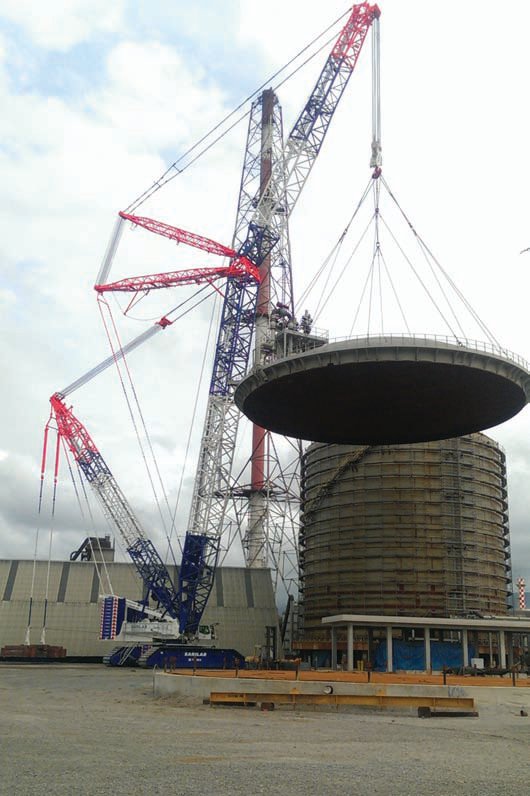 Sarilar assisted with the installation of a tank cover at Eti Bakir’s mineral processing plant at Samsun, Turkey.
Sarilar assisted with the installation of a tank cover at Eti Bakir’s mineral processing plant at Samsun, Turkey.
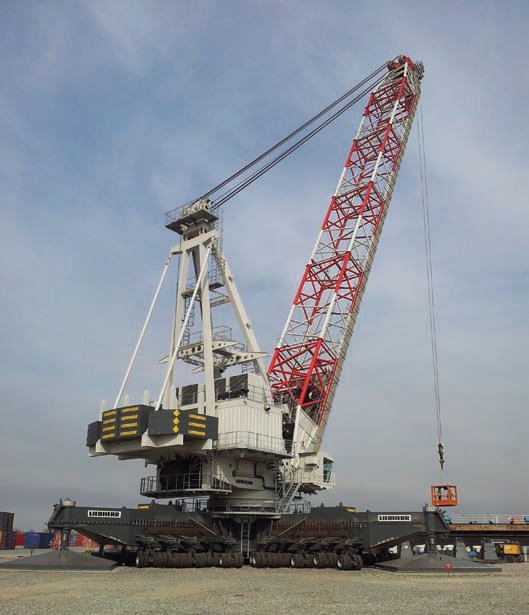 Liebherr assembled its first TCC 14000-400 D Litronic crane, which can operate as an offshore crane or a mobile harbour crane, in the port of Baku, Azerbaijan.
Liebherr assembled its first TCC 14000-400 D Litronic crane, which can operate as an offshore crane or a mobile harbour crane, in the port of Baku, Azerbaijan.
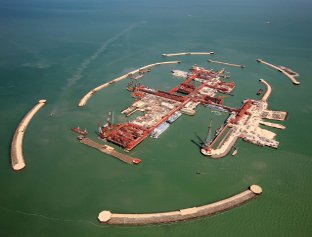 Liebherr has established a subsidiary at the port of Atyrau, Kazakhstan, near the Kashagan oil platform.
Liebherr has established a subsidiary at the port of Atyrau, Kazakhstan, near the Kashagan oil platform.
